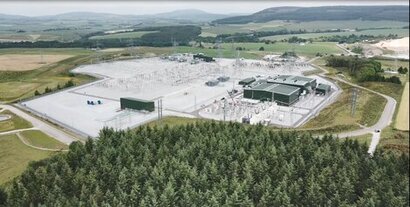
The agreement includes the deployment of up to five HVDC 'power corridors', or electricity transmission superhighways, to enable large amounts of future renewable power to be transported from northern Scotland to areas of higher consumption in the south. Each of these connection systems has a capacity of up to 2 gigawatts (GW) and a voltage level of 525-kilovolts (kV). The total 10 GW of renewable electricity capacity would provide the equivalent power consumption for around 10 million UK homes.
The links will help secure power transmission in the northern UK and support the integration of new renewable electricity generation in Scotland as part of the UK’s Net Zero Strategy. HVDC transmission will play a key role in bringing this vast amount of renewable power to communities across the country.
“We’re proud to once again collaborate with SSEN Transmission and be part of their journey to advance a sustainable energy future for all, as we continue to set the benchmark for deploying innovative solutions at scale and with speed” said Niklas Persson, Managing Director at Hitachi Energy’s Grid Integration business. “This business model reflects our strategy to secure clear visibility of the future and, based on this, we are already hiring to expand our global delivery capacity.”
The framework agreement reinforces how Hitachi Energy’s state-of-the-art HVDC technology can be deployed effectively and how new business models enable the scale needed to speed up the energy transition. This new approach allows Hitachi Energy to plan in advance to increase manufacturing capacity, expand and train the workforce, and maximise standardisation to increase synergies between successive projects.
“As we aim to conclude contract negotiations in the coming weeks and months, we look forward to building on our long-established and strong working relationship with Hitachi Energy” said Rob McDonald, Managing Director of SSEN Transmission. “We are also delighted that we have secured a place on our contractors’ framework for future HVDC projects, with significant further opportunities expected to come from ongoing system design work. Further details on these future projects and associated supply chain opportunities are expected later this year.”
Hitachi Energy will supply its voltage source converter (VSC) converter stations, which convert AC to DC for efficient, long-distance transmission and DC to AC, where the electricity is returned to the grid.
The first two projects under the framework agreement between Arnish-Beauly and Spittal-Peterhead have already been defined. The three additional projects are flexible in location, and to be defined as large-scale studies are finalized. The HVDC links are expected to enter operation in 2030 and onwards.
Hitachi Energy is collaborating with SSE on several key HVDC projects in the UK, such as the Caithness Moray and Shetland links, allowing efficient transmission of renewable power, increasing the reliability in the mainland grid, and improving the security of supply as well as the Dogger Bank Windfarm project, the largest offshore wind farm in the world. Hitachi Energy recently announced a similar large-scale agreement with TenneT to supply 12 GW of offshore wind connections in The Netherlands and Germany.
For additional information:

